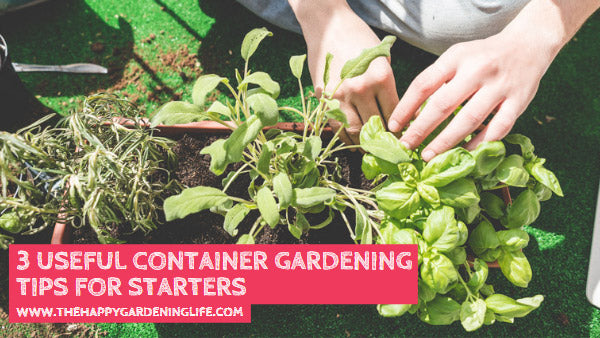
3 Useful Container Gardening Tips for Starters
Share
 If you’re hesitating to grow a garden because you don’t have enough space, then container gardening is the best option for you! It’s a good gardening method for new gardeners to try, but before you start, you need to consider some essential tips so you can succeed at container gardening.
If you’re hesitating to grow a garden because you don’t have enough space, then container gardening is the best option for you! It’s a good gardening method for new gardeners to try, but before you start, you need to consider some essential tips so you can succeed at container gardening.
The first thing to keep in mind is the container. Your containers should always have holes at the bottom to allow better drainage. They should also be deep enough, especially since many root crops and tall plants grow best in deep garden pots.
Soil is the second factor to consider. Always use high-quality, organic garden soil so your vegetables can achieve the right nutrients that will help them grow to their full potential. It’s also recommended to add organic matter like compost to provide even more nutrients and minerals for your plants.
Lastly, think about watering your container garden. Plants need a moderate amount of water to keep them healthy, but you’ll still need to check them regularly. If your plants are beginning to tilt and the soil is somehow dry, that’s a sign that they need more water.
So those are the Top 3 starter tips you should remember when growing a container garden. Please share these tips with your fellow gardeners today by clicking the social buttons below!
3 Useful Container Gardening Tips for Starters
1. Choose the right container
Drainage holes are a must. Only consider pots with holes or pots you can drill holes into. Select a container with a broad surface area. Decide what you’ll grow and that will help you to determine how deep your container should be. Root vegetables (think: carrots) and tall plants (like, tomatoes, vines and fruit trees) do better in deep pots. Fast growing crops like herbs and leafy vegetables are fine in a shallow container.
Shop around and you’ll see containers made of all types of material—clay, plastic, metal, wood, and even fabric. Each one has it’s pros and cons. For example, a clay pot looks awesome, but tends to dry out quickly; whereas a plastic pot holds water well, but isn’t as aesthetically pleasing.
2. Buy potting soil
You may be tempted to fill your container with the free dirt from your backyard, but don’t do it. Dirt from the ground doesn’t work well in containers because it’s dense and heavy. It turns into a hardened clump in your pot and your plants won’t do well. You need soil that is light, drains water quickly but also holds moisture at the same time.
Go to your local nursery and buy the best quality potting soil that fits within your budget. A good potting soil will have a variety of ingredients, such as compost, worm castings, wood chips, perlite, peat and vermiculite.
3. Water your plants
Avoid under-watering and be sure you aren’t over-watering your vegetables. How do can you be sure? Wait for the plants to look slightly wilted, then water it. You can also stick your finger in the soil about an inch down and see how it feels. If it’s dry, it’s time to water. The best tools for watering a container garden are a watering can and spray wand that attaches to the hose.
Article Source: homereadyhome.com
